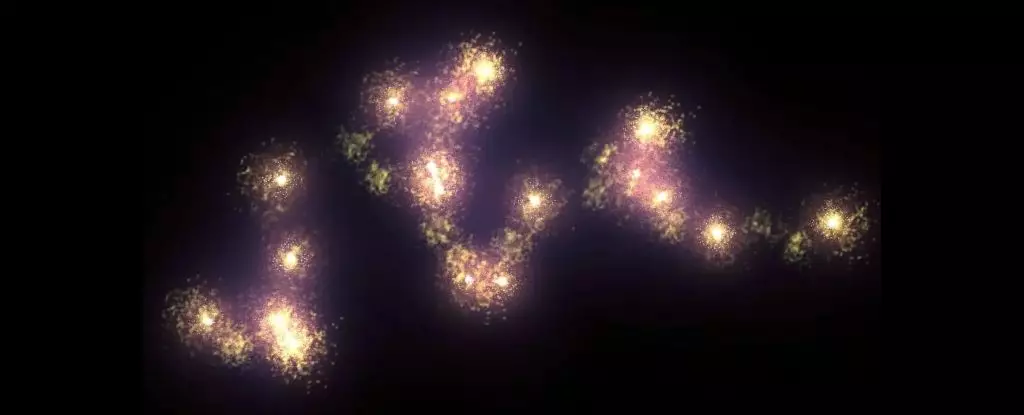In the grand narrative of astrophysics, few stories capture the imagination as vividly as that of the Hercules-Corona Borealis Great Wall. Once perceived simply as a remarkable structure spanning approximately 10 billion light-years, new analyses are suggesting it might actually exceed that estimate, stretching across an astonishing 15 billion light-years. This revelation shakes the foundations of our understanding of cosmic structures, compelling us to reconsider our position in the vastness of the Universe.
The examination of this colossal entity hinges on the intensive study of gamma-ray bursts—one of the Universe’s most ferocious phenomena. Predominantly arising from catastrophic events such as supernova explosions and neutron star collisions, these bursts serve a dual purpose: they not only illuminate the incredible power of celestial events but also provide invaluable insight into the structural makeup of the Universe itself. With their intense brightness, gamma-ray bursts allow astronomers to map the distribution of galaxies and their clusters over immense distances.
The Methodological Milestone
Recent research spearheaded by a team of astronomers, including István Horváth, Jon Hakkila, and Zsolt Bagoly, aimed to refine our knowledge surrounding this gigantic structure. They meticulously analyzed data from 542 gamma-ray bursts that were observed at different redshifts—essentially a measure of how much the Universe has expanded since the light they emitted was released. This approach enabled them to reassess the spatial extent of the Great Wall, leading to revelations that challenge prior cosmological norms.
The implications of their findings are monumental. If the Great Wall indeed stretches across 15 billion light-years, it inevitably disrupts the widely accepted cosmological principle, which posits that the Universe is uniform and homogeneous at large scales. Structures of such scale are not just fascinating; they are fundamentally provocative, raising crucial questions about the cosmic evolution and the underlying laws dictating the arrangement of matter across the Universe.
Challenges to Cosmological Norms
Historically, our understanding of the Universe’s fabric has been reinforced through countless evidences supporting the cosmological principle. However, the potential existence of superstructures like the Hercules-Corona Borealis Great Wall poses significant epistemological challenges. Structures larger than approximately 1.2 billion light-years represent an anomaly that traditional cosmological theories have struggled to accommodate.
To put this into context, consider the array of superstructures already identified. There are the Clowes-Campusano LQG and the Giant Arc, each presenting their own enigmas as they stretch across billions of light-years. Yet, none come close to the newly suggested dimensions of the Great Wall. As we delve deeper into this cosmic investigation, understanding the origins and implications of such vast structures remains a daunting yet crucial goal for astrophysicists.
The Road Ahead: Understanding the Universe’s Tailored Fabric
Despite the groundbreaking nature of these findings, one salient truth remains: we are just scratching the surface of our cosmic understanding. The Hercules-Corona Borealis Great Wall may not merely be an anomaly; it could reveal profound insights about the Universe’s evolution, structure, and the fundamental laws that govern it. As researchers contemplate the meaning behind these structures, the prospect of better comprehending the Universe beckons with tantalizing urgency.
This is a dynamic realm where new discoveries can rapidly alter our perspectives. The findings have been submitted for academic scrutiny and await publication, but they already fuel a lively discourse surrounding the intricate relationships between enormous structures and the evolution of cosmic fabric. Recognizing that many questions linger, we are reminded that each discovery brings us closer to unraveling the mysteries preceding our celestial surroundings.
The Human Element in Astronomy
In the pursuit of knowledge, it’s essential to acknowledge the humans behind these cosmic revelations. Astronomers like Horváth, Hakkila, and Bagoly represent a community driven by curiosity and the insatiable need to understand our place in the cosmos. Their relentless dedication reminds us that the Universe, despite its vastness, is inherently connected to our pursuit of knowledge. Each gamma-ray burst they analyze, each structure they measure, symbolizes not just a physical distance but an intellectual journey into the unknown.
As we stand on the precipice of astounding revelations, the Universe continues to speak to us through its extraordinary phenomena. The Hercules-Corona Borealis Great Wall may be an enigma, but it is one that calls to scientists everywhere, beckoning them to unravel its secrets. As we explore the depths of this cosmic colossus, we are inexorably reminded that we are mere specks within the grandeur of the Universe, yet our quest for understanding renders us immensely significant in the grand tapestry of existence.


Leave a Reply